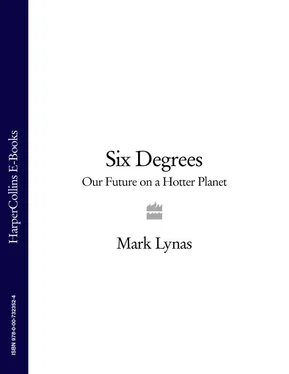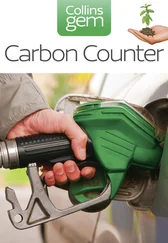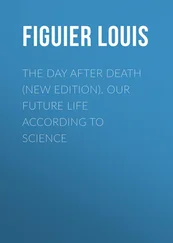It is also important to note that the temperature scale of this book is based on the IPCC's landmark 1.4 to 5.8°C temperature range, published in its 2001 Third Assessment Report, which gives us predictions of up to six degrees. This is reflected in the structure of the chapters that follow. The three degree chapter, for example, covers global temperatures of 2.1°C to 3°C, whereas the six degree chapter covers 5.1°C to 5.8°C. In February 2007 the IPCC published its Fourth Assessment Report (AR4), which broadened the range of temperature projections for 2100. For the lowest emission scenario, where global greenhouse gas emissions dip sharply, warming by 2100 could be as low as 1.1°C, according to the AR4, whereas for the highest emissions scenario, global warming could reach 6.4°C. In other words, the range is broader, and the worst-case scenario is even more drastic than in the 2001 IPCC report-seven degrees on this book's scale.
The Fourth Assessment Report of the IPCC also surveys in detail the expected impacts of future climate change, covering much of the same territory as this book and referencing many of the same papers. The language is sufficiently non-technical for most laypeople to find it perfectly comprehensible-something of an improvement on previous reports. I would in particular direct interested readers to the Working Group II section of the AR4, in particular a table in the Summary for Policymakers which outlines in a simple degree-by-degree scale the expected impacts of warming from 1 to 5°C. (Why the table does not extend to six degrees, despite this being within the temperature scenario projections given by the IPCC, is not explained.) The full text of all IPCC reports is available on the web at www.ipcc.ch.
An admitted pitfall in choosing a temperature-based structure for this book is that it makes giving dates very hazardous. The world could become two degrees warmer by 2100, for instance, or it could already have hit that level as early as 2030. The speed of warming is crucial in determining the capacity of human civilisation and natural ecosystems to adapt to the changing climate, and readers are urged to bear this in mind. The other option of running through the twenty-first century decade by decade would, I feel, have been even more problematic given that the dates attached to different emissions scenarios and temperature changes are highly uncertain. This book only deals with what scientists call ‘transient’ climate change: because of the thermal inertia of the oceans it will take centuries for temperatures to stabilise at any given concentration of greenhouse gases into a so-called ‘equilibrium’ state.
I have also on occasion explored rather speculatively what the changes projected by today's scientists might mean for society in future. Might China invade Siberia to secure subarctic Lebensraum in a globe where only narrowing zones remain habitable? Might India and Pakistan's struggle over the diminishing headwaters of Himalayan rivers turn nuclear as their people go thirsty? Of course, I would be foolish to expect these predictions to come true in any literal sense-history teaches us that human events are too unpredictable to support such a deterministic approach. But of this I have no doubt: climate change is the canvas on which the history of the twenty-first century will be painted. Forewarned is forearmed.
Onward, then. Let us enter the Inferno together.
1° Table of Contents Epigraph From the weeping ground there sprang a wind, flaming with vermillion light, which overmastered all my senses, and I dropped like a man pulled down by sleep. Dante, Inferno , Canto III: Dante enters the First Circle of Hell Introduction Part 1 - 1° Chapter 1 - One Degree Part 2 - 2° Chapter 2 - Two Degrees Part 3 - 3° Chapter 3 - Three Degrees Part 4 - 4° Chapter 4 - Four Degrees Part 5 - 5° Chapter 5 - Five Degrees Part 6 - 6° Chapter 6 - Six Degrees Part 7 - 7 Chapter 7 - Choosing Our Future Notes Index Acknowledgements Also by Mark Lynas Copyright About the Publisher
Конец ознакомительного фрагмента.
Текст предоставлен ООО «ЛитРес».
Прочитайте эту книгу целиком, купив полную легальную версию на ЛитРес.
Безопасно оплатить книгу можно банковской картой Visa, MasterCard, Maestro, со счета мобильного телефона, с платежного терминала, в салоне МТС или Связной, через PayPal, WebMoney, Яндекс.Деньги, QIWI Кошелек, бонусными картами или другим удобным Вам способом.












